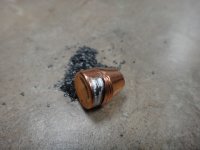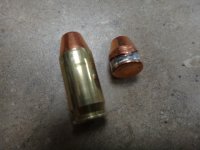You are using an out of date browser. It may not display this or other websites correctly.
You should upgrade or use an alternative browser.
You should upgrade or use an alternative browser.
45 acp case mouth belling
- Thread starter rebs
- Start date
USMC 77-81
New member
The mouth needs to be belled, otherwise you may, and eventually will, shave the jacket material, I've done so twice and then learned my lesson.
1st Marine division, 3rd Marines
1st Marine division, 3rd Marines
101combatvet
New member
Crazy, without the bell you will normally be shaving slight amounts of copper from the jacketed bullet. I always use a slight bell to prevent this from happening.
I have looked at it a little differently before mikld's way of explaining it.
With my thin case K Hornet rounds. I have some flat base bullets that shoot well but hang up wile seating the bullet. I found that if I would very gently tap the bullet to get it started it would seat. Although I would crush the necks if I wasn't very gentle. I see no reason not to bell the 45 ACP case.
If you want FAST loading get your self a expensive progressive press. It is a good way to save time with a high production rate.
With my thin case K Hornet rounds. I have some flat base bullets that shoot well but hang up wile seating the bullet. I found that if I would very gently tap the bullet to get it started it would seat. Although I would crush the necks if I wasn't very gentle. I see no reason not to bell the 45 ACP case.
If you want FAST loading get your self a expensive progressive press. It is a good way to save time with a high production rate.
I bell all my handgun cases.
I do not bell but chamfer all of my rifle cases.
If you refuse to bell your handgun cases, at least chamfer the mouth of the case and stick to loading copper jacked bullets only. No lead. No plated.
http://www.midwayusa.com/product/789334/le-wilson-chamfer-and-deburring-tool-17-to-45-caliber Read the comments.
I do not bell but chamfer all of my rifle cases.
If you refuse to bell your handgun cases, at least chamfer the mouth of the case and stick to loading copper jacked bullets only. No lead. No plated.
http://www.midwayusa.com/product/789334/le-wilson-chamfer-and-deburring-tool-17-to-45-caliber Read the comments.
Last edited:
I have skated by with minimal flaring on 45ACP loads with jacketed bullets and not had a problem. I tired the same with 38/357, and not so much. The longer case tends to less forgiving with the pressure of putting a bullet in an unflared case. A few mangled bullets and a few mangled cases later, I flared them more and no problem.
When reloading both .45 ACP & .38/.357, I've occasionally encountered cases that I THOUGHT had been belled enough, but were either not belled enough, or not belled at all. I've tried seating all kinds of projectiles on these, just to see if I could. Nothing catastrophic ever happened, but the rounds DID create flyers, so accuracy does suffer.
I'M "precision challenged" enough, when I do everything the right way. When I introduce other factors into the equation, I inevitably lose accuracy. The only exception is taper-crimping in a separate step, which helps MY accuracy a great deal.
This suggestion may seem either retarded or obsessive-compulsive, but it saves me a lot of headache later: When I bell case mouths on a lot of (say, 25 or 50) pistol/revolver brass, I'll go back with one of the to-be-seated projectiles and try it in the case mouth to see if it will just barely seat into the "bell" of the case mouth. If I see the bottom of the projectile disappear completely, I conclude that it's belled enough (perhaps too much, if case life is a concern).
I'M "precision challenged" enough, when I do everything the right way. When I introduce other factors into the equation, I inevitably lose accuracy. The only exception is taper-crimping in a separate step, which helps MY accuracy a great deal.
This suggestion may seem either retarded or obsessive-compulsive, but it saves me a lot of headache later: When I bell case mouths on a lot of (say, 25 or 50) pistol/revolver brass, I'll go back with one of the to-be-seated projectiles and try it in the case mouth to see if it will just barely seat into the "bell" of the case mouth. If I see the bottom of the projectile disappear completely, I conclude that it's belled enough (perhaps too much, if case life is a concern).
Glad to see you changed your mind. I will add my two cents anyway.
Without belling you have to carefully hold the bullet in place while inserting it in the shell holder. First, I think this really slows down the process. Two, I have on occasion held on a bit too long and pinched my fingers. Third, as I have a few times dropped the case I am glad the bullet is inserted into the bell so it stays in place. Otherwise I've got some powder on the floor that needs to be cleaned up.
Without belling you have to carefully hold the bullet in place while inserting it in the shell holder. First, I think this really slows down the process. Two, I have on occasion held on a bit too long and pinched my fingers. Third, as I have a few times dropped the case I am glad the bullet is inserted into the bell so it stays in place. Otherwise I've got some powder on the floor that needs to be cleaned up.
condor bravo
New member
Another two cents worth that by now are just repetitious. Certainly flare somewhat for jacketed bullets, not as much required as for cast, otherwise some collapsed cases or sheared bullets will probably occur. And the flare makes straight bullet seating that much more reliable. Then remove the flare with a taper or roll crimp as appropriate for the bullet type (lead or jacketed with or without a cannelure or crimping groove).
A very slight bell, just so the bullet sits straight on the case before seating. Then using a Lee Factory Crimp die, I straighten the bell out just enough that the case is straight walled again. No crimp just a touch up to straighten the case back.
Works every time and seats the bullets straight and square to the case.
Stay safe.
Jim
Works every time and seats the bullets straight and square to the case.
Stay safe.
Jim
always bell
I agree with most others that belling is important. However, in my experience, I believe belling is more important with lead bullets than jacketed, even though I bell both. The reason belling is more important with lead is to prevent shaving which almost certainly has to affect accuracy. Since jacketed bullets have a "hard" case, they may scratch, but should not be shaved. Plated bullets fall in between and may or may not shave.
I agree with most others that belling is important. However, in my experience, I believe belling is more important with lead bullets than jacketed, even though I bell both. The reason belling is more important with lead is to prevent shaving which almost certainly has to affect accuracy. Since jacketed bullets have a "hard" case, they may scratch, but should not be shaved. Plated bullets fall in between and may or may not shave.
blue dingo
Inactive
Yep, and even when you put a slight bell on there can still be problems. Especially with the plated bullets like this Rainier 185 gr in 45 Auto.

After loading several hundred without issue this one peeled off on one side. A quick removal and inspection of the brass looked fine and another plated bullet went right in.

After loading several hundred without issue this one peeled off on one side. A quick removal and inspection of the brass looked fine and another plated bullet went right in.


